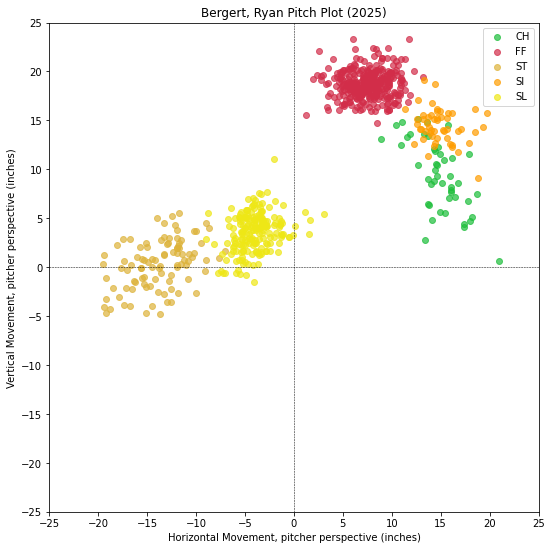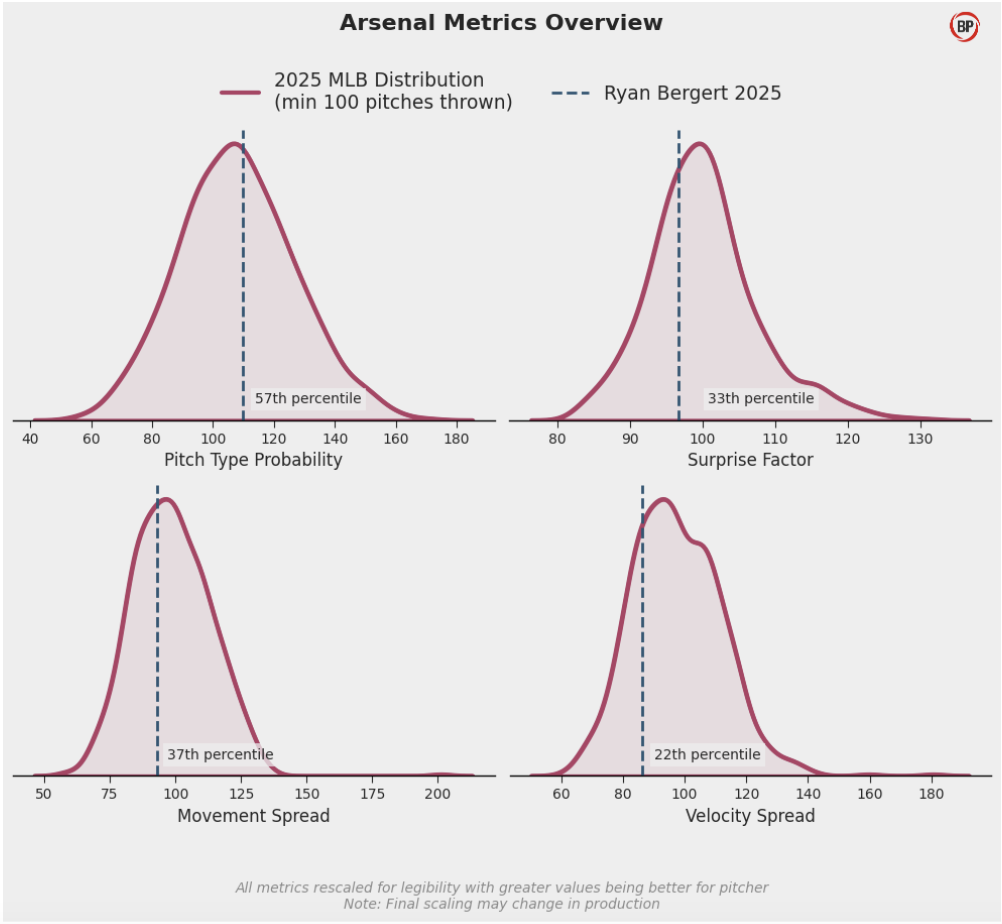In at Least One Respect, Ryan Bergert Looks Like an Ace

There’s no such thing as a perfect pitcher. There are guys with an incredible ability to spin the ball, but nothing to throw for whiffs at the top of the zone. (Mitch Keller and Matt Brash come to mind.) Some pitchers pump backspin four-seamers, but never settle on a reliable secondary. (Ryne Nelson, I’m looking at you.) Excelling at one thing often means being deficient at another.
Still, even if there are no perfect pitchers, there are some who come closer than others. Prime Gerrit Cole featured a carry heater and a firm slider with meaningful horizontal break. Jacob deGrom? Same deal. Some guys break our general understanding of the tradeoffs between certain pitch types. Most of those guys are aces. One of them is Ryan Bergert — at least potentially.
If that name rings a bell, it’s likely because Bergert featured in a deadline deal that brought him to Kansas City (along with Stephen Kolek, a rock-solid fifth starter type) in exchange for backup catcher Freddy Fermin. In these early days following the trade, Fermin is acquitting himself well, lining a bunch of base hits and striking out just once so far.
Fermin is valuable — especially to the catcher-deprived Padres — though not particularly exciting. He’s under team control for the rest of the decade, but he’s firmly locked into the “light-hitting backstop with excellent defensive skills” archetype. Bergert, on the other hand, strikes me as a guy with serious upside.
The results aren’t quite there yet, at least in terms of the peripherals, but Bergert is able to do two things that guys who aren’t named Cole or deGrom generally can’t: He can backspin a fastball, and he can throw a firm breaking ball with a bunch of horizontal movement:

Bergert won’t blow you away with velocity. He averages 93.6 mph on his four-seam fastball, almost a tick and a half below the league average for righties. (That’s probably why Stuff+, PitchingBot, and StuffPro all think his four-seamer is close to a league-average offering.) But the shape is premium. Bergert gets nearly 19 inches of induced vertical break on his heater, ninth-most among starters with at least 250 fastballs thrown:
| Player Name | Induced Vertical Break (in.) |
|---|---|
| Nick Pivetta | 19.9 |
| Tyler Anderson | 19.5 |
| Bryce Miller | 19.4 |
| Ryne Nelson | 19.4 |
| Ryan Pepiot | 19.2 |
| Landon Knack | 19.2 |
| Ronel Blanco | 18.8 |
| Bailey Falter | 18.7 |
| Ryan Bergert | 18.6 |
| Justin Verlander | 18.6 |
Bergert’s over-the-top arm angle (50 degrees) and unremarkable vertical approach angle negate some of the deceptive effects of the pitch, but it still gets about an inch and a half of unexpected ride, per Alex Chamberlain’s dynamic dead zone estimate. Ryan Pepiot’s backspin fastball is a solid comparison; even with so-so release characteristics, Pepiot’s heater still generates a bunch of swinging strikes at the top of the zone thanks to its vertical movement.
As in the case of Pepiot, the plus ride on Bergert’s fastball is a function of his backspin bias. His 95% fastball spin efficiency suggests he belongs to the pronator class of pitchers, tending to get “behind the ball” at release. Pitchers with this bias struggle to throw pitches with seam-shifted wake, like sweepers or sinkers, which depend on lower spin-efficiency release. As a result, you usually won’t see a pronator throwing a sweeper; it’s difficult to get to that big horizontal shape without altering the grip on the ball to the point that it loses effective velocity.
Tyler Zombro discusses the velocity tradeoffs that pronators must make to throw glove-side breaking balls in a Tread video I’ve referenced before, titled “How To Customize Your Pitching Arsenal (Pronation vs. Supination).” In the section on pronators, Zombro points out that “if you’re more behind the ball, and you struggle to get around it, the velo deficit it will take for you to get to [zero inches of horizontal break] is going to be -8, -10 mph.”
Here’s where Bergert is special. Even with pronator traits — a fastball with high spin efficiency and significant total movement — he can get to a sweeper shape with minimal velocity sacrifice. Bergert gets over 13 inches of horizontal break on his sweeper with only 10 mph of velocity deficit.
The table below shows the unusual nature of Bergert’s fastball-sweeper relationship. To that end, I measured the sweeper-fastball velo differential for all carry fastball pitchers. The vast majority, naturally, do not throw sweepers. Of the 27 pitchers who do, only three had a smaller gap in velocity between their four-seam fastball and their sweeper: Lake Bachar, Kris Bubic, and Cade Povich. And none of those guys get as much horizontal movement on their sweeper as Bergert does:
| Player Name | Four-Seam Velocity | Sweeper Velocity | Velo Diff |
|---|---|---|---|
| Lake Bachar | 94.2 | 86.2 | 7.9 |
| Kris Bubic | 92.2 | 82.9 | 9.3 |
| Cade Povich | 92.1 | 82.7 | 9.4 |
| Ryan Bergert | 93.6 | 83.6 | 10.0 |
| Shota Imanaga | 90.8 | 80.2 | 10.6 |
| Yuki Matsui | 92.2 | 81.2 | 10.9 |
| Ben Casparius | 96.2 | 85.2 | 11.0 |
| Drew Rasmussen | 95.7 | 84.7 | 11.1 |
| Casey Mize | 94.6 | 83.5 | 11.1 |
| Ronny Henriquez | 96.5 | 85.3 | 11.2 |
Is this enough on its own to make him a good pitcher? I’m not exactly sure. His overall arsenal scores, per Baseball Prospectus‘ Stephen Sutton-Brown, are unimpressive. His fastball features excellent movement, but it doesn’t tunnel particularly well with his slider or sweeper. The velocity spread between his pitches is relatively narrow; he doesn’t have a big loopy curveball to offset hitters’ timing, and his changeup remains a work-in-progress:

But I believe the Royals see the outlines of a special pitcher. In his two starts following the trade, Bergert has already ramped up his sweeper usage, particularly to left-handed hitters. In his first start, a 5 2/3 inning effort at Fenway where he allowed just two hits and two walks, Bergert kept whipping that sweeper backdoor to steal early-count strikes. Because Bergert generally targets the outer edge with his fastball, it’s nearly impossible for hitters to pull the trigger when he swings in the sweeper from way outside:
These repertoire changes are translating to early success. Bergert delivered the start of his young career Sunday, hanging one slider for a two-run home run but otherwise dominating the Twins over 5 2/3 innings, tying a career-high with eight strikeouts.
Even with these advances, Bergert is still relatively early in his development journey. As recently as last season, he threw from a relatively conventional three-quarters slot. As Eric Longenhagen wrote in June, “[Bergert] and the Padres have made successful changes to his delivery and pitch mix that have his fastball playing better in 2025 than ever before. Berget’s arm slot has been raised, and he’s added a tick of velo, now sitting 94 with more pure vertical movement because of his new release point.” Eric shared some Double-A data with me from prior to Bergert’s slot change. In early 2024, he was sitting three inches lower with four fewer inches of extension. This year, he’s hiked up that release point, moved further down the mound, and added backspin to his fastball.
The adaptability is auspicious. If Bergert can develop his changeup, add a slow curveball, or start locating his heater above the zone rather than on the outer edge, he might start to approach the point where he looks like a very good starting pitcher. At the very least, the fastball/sweeper combo is a fine place to start, and could perhaps be the blueprint for him developing into an ace.
Michael Rosen is a transportation researcher and the author of pitchplots.substack.com. He can be found on Twitter at @bymichaelrosen.

As a Padres fan, Bergert was the one outgoing guy I was most disappointed to give up at the deadline. He seems like a clear rotation piece with upside, exactly the sort of controllable arm teams cherish. So far so good with The Ferminator though, and you’ve gotta give up something to get something! Hope the deal works out for both teams.
Yeah it was certainly an overpay from a value perspective but the padres desperately needed a catcher and the catcher market was very dire
SD had to get a quality catcher and if the cost was Bergert oh well. Their pitching factory will find and develop another Bergert.